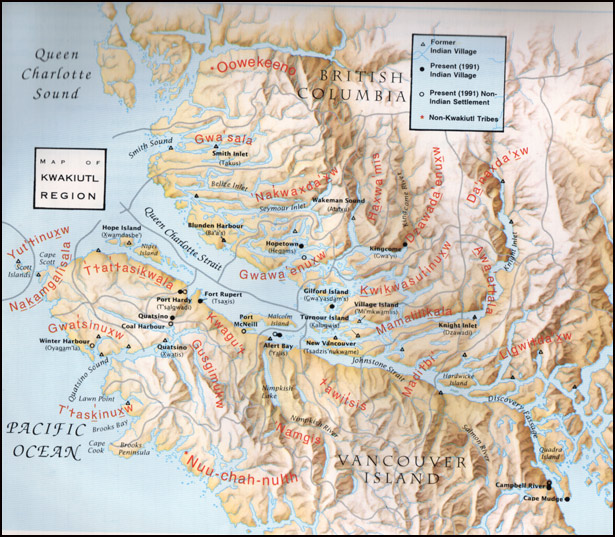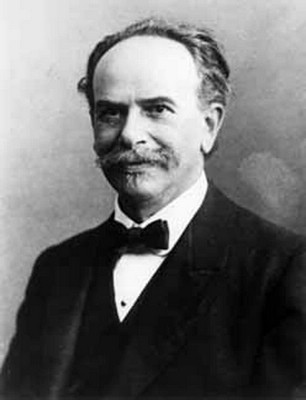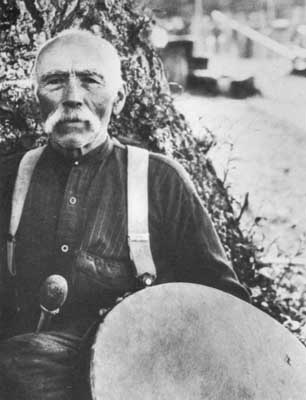The Kwakiutl are one of several indigenous First Nations that inhabit the western coast of British Columbia, Canada, from central and northern Vancouver Island to the adjacent mainland coast. In the 1980s, the Kwakiutl officially changed their name to Kwakwaka'wakw, meaning “Kwak'wala speaking tribes”, though the two names are often used interchangeably by scholars and some Kwakiutl bands. Kwakiutl bands consist of four clans: the Raven, Killer Whale, Eagle, and Wolf clans, and each band consists of two or more numaym (or ‘na’mima) - ranked descent groups each claiming their own ancestor, chiefs, oral histories, and entitlement to certain lands, religious rites, and songs and dances associated with particular family names and masks (Boas 1966: 37; Kirk 1986: 38; Rosman and Rubel 1990: 622; Suttles 1991: 86). The numaym constitute the most basic social group in Kwakiutl society.

Map of Kwakiutl Territories
(from Jonaitis, et al 1991)
Marriage among the Kwakiutl typically occurs between two people from different numaym, and is most commonly used to transmit ceremonial privileges and familial names and masks (Suttles 1991: 92). It is expected that a suitor’s family will pay a bride price to his prospective wife’s family, which is to be paid back by the father of the bride over time, often exceeding the cost of the original payment significantly and including the imparting of ceremonial privileges to the groom. The rules surrounding marriage and annulments are extensive and often quite complicated. For instance, if a family has no daughter but wishes to extend their name, property, or masks and ceremonial privileges, a “fictitious” marriage may occur. Concerning annulment, if a bride price was paid in full, it could be decided by the bride’s father that the marriage had been annulled and the bride then married to someone else, with each successive marriage bringing higher social rank to the bride until, at her fourth marriage, her social rank is soundly-established (Boas 1966: 55).
As with many societies, rank and wealth were clearly important components of Kwakiutl social life. Yet, for the Kwakiutl, these forms of status took on a distinct form of social practice and were perhaps most explicit in the inheritance and performance of masks and dances. In an early description of the Kwakiutl, eminent anthropologist Franz Boas noted:
“The acquisition of a high position and the maintenance of its dignity require correct marriages and wealth -- wealth accumulated by industry and by loaning out property at interest -- dissipated at the proper time, albeit with the understanding that each recipient of a gift has to return it with interest at a time when he is dissipating his wealth. This is the general principle underlying the potlatch…” (Boas 1966: 51)
Thus, for Boas, the potlatch ceremony could be understood to express quite fully the social dynamics that traditionally governed Kwakiutl life, a position enthusiastically supported by many contemporary researchers, Kwakiutl and non-Kwakiutl alike (Cranmer Webster 1991: 238-240; Jonaitis 1991: 11-12). Masks figured prominently in the potlatch ceremony, as family members performed masked dances as both the fulfillment of their obligations to their numaym and a display of their new social status and family’s genealogy. For more on the potlatch, see the section entitled “Kwakiutl Ceremonial Life”.
 Franz Boas, ca. 1915 (Source: Wikipedia) |
 George Hunt, ca. 1920 (from Jonaitis, et al 1991) |
It should be noted that much of our early knowledge about the Kwakiutl is attributed to Franz Boas (1858-1943), and his close associate George Hunt (1854-1933). Boas, the first - and perhaps most famous - anthropologist to work with the Kwakiutl, conducted intermittent field work in the Northwest Coast between 1885 and 1930, engaging in ethnographic interviews, compiling myths and oral histories, charting Kwakiutl social and political organization, and observing festivals and ceremonies. Not without controversy, Boas was also an active collector of native skeletons used in early scientific research. George Hunt, a Kwakiutl considered by some to be among the first native anthropologists, described himself as a “collector” and served as a translator and guide for Boas and several other prominent anthropologists engaged in ethnography and collecting, including renowned photographer Edward Curtis and the MPM’s own Samuel A. Barrett (Jacknis 1991: 177, 211).

